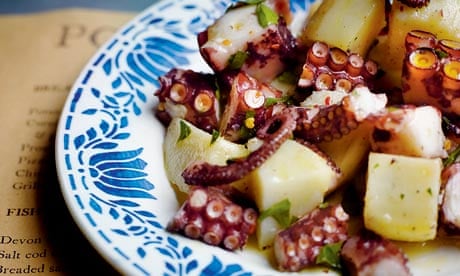Pizzetta bianca
We make pizzetta, which are slightly smaller than pizza, about 20cm in diameter rather than 30cm. As well as being prettier, this size is also more convenient – you might get two or three pizzetta on to your pizza stone rather than a single large one. We use fresh yeast, which you can find in health food shops, bakeries and even by asking at the bakery departments of some supermarkets. Otherwise use sachets of fast-action dried yeast.
This simple pizzetta is a variation on the classic Roman pizza bianca (not really a pizza at all, more like flatbread with olive oil, rosemary and salt). Our version has two white cheeses and thyme. It is so fragrant and pungent that it turns heads as it is taken through the restaurant. "What was that?" everyone asks. They always order one for themselves. In this instance, it is better to use dense, cheap mozzarella rather than expensive, moist buffalo varieties. The cheaper stuff is very easy to grate and has less water content and therefore melts better.
For the pizzetta base (makes 12 bases)
fresh yeast 15g (or 1 × 7g sachet fast-action yeast)
tepid water 300ml
strong white flour, Italian 00 is good 500g
fine salt 2 tsp
extra-virgin olive oil 2 tbsp
Whisk together the fresh yeast (if using) and the water. You can make cold water tepid by adding a splash from a boiled kettle. In a large bowl, mix the flour, salt and dried yeast (if using) with the olive oil and the yeasty (or plain) water and form the mixture into a ball. Now knead the dough on a floured work surface. To do this, push the dough backwards and forwards simultaneously with your two hands so that you are stretching it and then pushing it back down into a ball. Repeat this, giving the dough a good working over. You shouldn't break into a sweat but it should feel like a little workout for your hands and forearms, and you should be feeling the dough getting more and more springy. After 10 minutes of kneading, push the dough back into a ball, flour the top, place in a bowl and cover with oiled clingfilm. Leave to rise in a warm place.
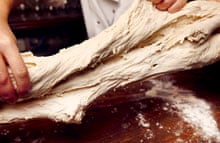
After at least 30 minutes, but ideally when doubled in size, your dough is ready. Divide the dough into 12 large golf-ball-sized pieces and then roll them into thin 20cm discs. Top with the rest of your ingredients (below) and cook. If you want to use the dough later, place the balls of dough on a tray, cover with a damp cloth and leave in the fridge for up to 12 hours. Just remember to take them out 30 minutes before you're ready to use them.
Remember that your pizza will benefit from being placed directly on to a hot baking sheet or pizza stone within a preheated oven – our pizzas take no longer than 5 minutes. At 250C/gas mark 9, yours will take about 6-8 minutes.
Finally, please don't worry about getting totally round and even bases for your pizzetta. In fact, it's much better if they are not; you'll get some lovely bubbling and occasional charring.
For 1 pizzetta bianca
pizza dough 1 large golf-ball-sized piece
(see above)
block mozzarella 1 small handful, grated
parmesan 1 small handful, grated
small red onion ¼ , thinly sliced
picked thyme leaves about 12-15
black pepper
extra virgin olive oil
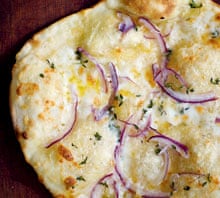
Preheat your oven to its highest setting (250C/gas mark 9 or above). At the same time put a pizza stone or baking sheet in the oven to heat up. Roll the pizza base out to around 20cm in diameter. Evenly distribute the cheeses, the onion and almost all of the thyme over the pizza base. Be sparing – a little goes a long way. If you use too much topping, the base won't be crisp enough. Around 6 minutes on a pizza stone should do for this one. Don't burn the cheese. Just before serving, grind on some pepper, sprinkle over a little olive oil and scatter over the remaining thyme leaves.
Warm octopus salad
Octopuses aren't something your fishmonger will necessarily have as a matter of course. You might have to ask him in advance so that he can order one for you. You need just a small beast for this recipe, about the size of a grapefruit.
This recipe is the only instance in this book where you are permitted to use a microwave, and only because it is the technique used by Mirella at Alla Vedova in Cannaregio. The version here is based on the dish that she serves at her charming osteria. I love the gentle spice in this salad; it reminds me of the use of smoked paprika in the traditional Spanish preparation of octopus. Transfer the dressed octopus to a large serving plate and cover with clingfilm. When you are ready to serve, put the dish in a microwave on full for 30 seconds so that the potatoes and octopus gain a little warmth.
SERVES 4
octopus 1 medium, 1½-2kg
fennel bulb 1, cut in half
onion 1, cut in half
celery stalks 2, cut roughly
parsley stalks 1 handful, roughly chopped
potatoes 3 medium waxy, peeled
garlic clove 1, finely chopped
flat parsley leaves 1 handful, chopped
chilli flakes 1 tsp
flaky sea salt and black pepper
extra-virgin olive oil 4 tbsp
lemon juice 1 tbsp
First you need to soften up your octopus. You do this simply by freezing it and then thawing; this breaks down the toughness in the cellular structure of the flesh. In a very large pan, simmer the octopus in unsalted water on a medium-low heat with the fennel, onion, celery and parsley stalks until tender enough to push a fork easily through the flesh. This should take no more than 1 hour.
Remove the octopus from the cooking water and allow it to cool. Cut the cooked and cooled octopus into bite-sized pieces, discarding the eyes, beak and the mush inside the head. Remove the skin. Rinse the cut pieces in clean water.
Cut the peeled potatoes into bite-sized pieces, put into a pan of water, bring to the boil and then simmer until cooked. Be careful not to overcook – they should not disintegrate. Drain and set aside.
In a large mixing bowl, gently combine the octopus and potatoes with the garlic, parsley and chilli flakes. Season with salt and pepper and dress with olive oil and lemon juice.
Broad bean, mint and ricotta bruschette
This is easily one of the most popular dishes on the summer menu at Polpo. The bright colours are such strong indicators of the flavours that are to follow, but despite the assertiveness of the ingredients, it is still a subtle and delicate combination.
Ricotta is readily available from Italian specialists and even in good supermarkets now. This dish is a joy to prepare. I don't know about you, but podding and skinning broad beans is one of my favourite kitchen pastimes. No, really, it is.
For 2 bruschette
podded broad beans 1 good handful
extra-virgin olive oil 2 tbsp, plus more for the bread
lemon 1, zest and a little juice
mint leaves 10, roughly chopped
flaky sea salt and black pepper
sourdough or soda bread 2 thick slices
garlic clove ½
fresh ricotta 3 tbsp
Place the broad beans into boiling water for 5 minutes, remove and plunge into cold water, then drain and skin them. Put the beans in a small bowl and dress them in the olive oil, the lemon zest, a little lemon juice and most of the chopped mint. Season with salt and pepper.
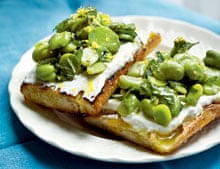
Toast or grill the slices of bread so that they are crunchy on the outside but still have a bit of give when squeezed. Rub one side of each slice a few times with the cut side of the garlic clove so that it melts into the bread's hot surface. Drizzle with some olive oil.
Season the fresh ricotta with salt and pepper, to taste, then spread on to the hot, garlicky bread. Top with the broad beans and garnish with the remaining chopped mint.
Pork belly, radicchio and hazelnuts
This dish has become something of a signature at Polpo. Whenever we take it off the menu to add some seasonal variety or to trial a new dish, there is an outcry from regulars. It is a simple recipe with only three main ingredients. The sweet, hot cooking juices from the pork coat and wilt the bitter radicchio leaves, and the hazelnuts add a good crunch. A compelling combination.
SERVES 4-6
hazelnuts 200g
onion 1, thickly sliced
pork belly 1 kg
flaky sea salt and black pepper
extra-virgin olive oil
radicchio 1 large head
red wine vinegar 1 tbsp
Preheat the oven to 180C/gas mark 4 and roast the hazelnuts on a baking sheet for 5 minutes, taking care they do not burn. Leave to cool then roughly chop.
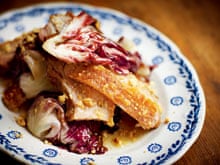
Turn the oven up to 240C/gas mark 9. Put the sliced onion into a roasting tin and place the pork belly on top, skin-side up. While the oven comes up to temperature, score the skin of the pork with a very sharp knife or a razor blade. You could use a clean Stanley knife from your toolbox.
Rub salt into the skin of the pork and smear with a little olive oil. Place the pork in the preheated oven for 10-15 minutes, until browned. Turn the oven down to 160C/gas mark 3 and continue to cook for about 1 hour or until tender. During the cooking time add a little water if the pork and onions start sticking or burning. Remove the pork belly when cooked and allow to rest and cool slightly. Collect all the juices from the pan and pass through a fine sieve.
Core the radicchio and remove all the leaves, tearing the larger ones in half. Place in a large mixing bowl. Use the warm pork fat and juices to dress the radicchio salad with the toasted and chopped hazelnuts.
Slice the pork belly and place in the bowl with the radicchio and hazelnuts. Splash over the red wine vinegar and add a pinch of salt and pepper. Scrunch the salad together with your hands so that the dressing mixes through and the radicchio warms and wilts.
Prosciutto and butternut squash with ricotta salata
This recipe is so simple it is almost embarrassing, but it is one of my favourite uses of butternut squash. When squash is roasted it takes on a remarkably sweet flavour and a delightful velvety texture. And when combined with the salty tang of the ricotta and prosciutto, this dish really sings.
It is important that you buy your sliced prosciutto from a good Italian delicatessen. The slices should be so thin that you can almost see through them. You will also get your ricotta salata here – it's a salted, firm variation of the normally soft cheese and is perfect for grating.
SERVES 4-6
butternut squash 2 medium
extra-virgin olive oil
flaky sea salt and black pepper
sage leaves 10, torn
prosciutto 8 large slices
ricotta salata 200g
pumpkin seeds 1 handful
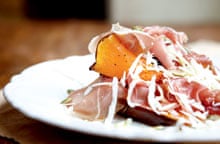
Preheat the oven to 200C/gas mark 6. Cut the squashes in half and remove the seeds and the hard stalk. Now cut the remaining halves into large bite-sized pieces. Scatter them on to a roasting tray and splash on a good amount of olive oil, add a good pinch of salt and pepper and the torn sage leaves.
Roast the butternut squash in the preheated oven until cooked throughout (about 20-30 minutes). A good way to check is to see if a knife can be pushed into the middle and pulled out with minimum force and resistance.
Remove the squash from the oven and while still warm put on plates, drape over the thinly sliced prosciutto, grate over the ricotta salata and drizzle with a little olive oil. Sprinkle over the pumpkin seeds for texture and a little added crunch.
Zucchini, basil and parmesan salad
A startlingly simple salad that is delightful and surprising, this is one of the most requested recipes at Polpo. The trick here is to slice the zucchini as thinly as possible. The wafer-thin slices take on a delicacy that we don't normally associate with zucchini. It is also important to make sure the salad is not overdressed – you want the elements to be daintily and lightly coated rather than doused.
SERVES 4-6
lemon juice of 1
extra-virgin olive oil 6 tbsp
parmesan 2 tbsp, heaped, finely grated
flaky sea salt and black pepper
zucchini 4
rocket leaves 1 large handful
basil leaves 1 small handful
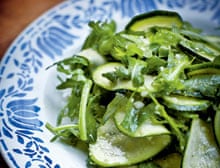
First make the dressing by mixing the lemon juice with the olive oil, the finely grated parmesan and a little salt and black pepper.
Finely slice the zucchini on an angle (or use a mandoline if you have one) and put into a bowl. Mix this with the rocket, basil and enough of the dressing to coat. Taste, adjust the seasoning and serve immediately.
